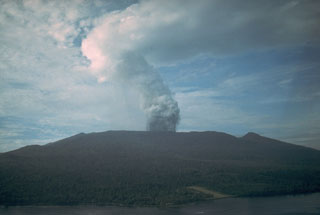Report on Karkar (Papua New Guinea) — October 1978
Scientific Event Alert Network Bulletin, vol. 3, no. 10 (October 1978)
Managing Editor: David Squires.
Karkar (Papua New Guinea) Explosion sounds; new incandescent area; increasing seismicity
Please cite this report as:
Global Volcanism Program, 1978. Report on Karkar (Papua New Guinea) (Squires, D., ed.). Scientific Event Alert Network Bulletin, 3:10. Smithsonian Institution. https://doi.org/10.5479/si.GVP.SEAN197810-251030
Karkar
Papua New Guinea
4.647°S, 145.976°E; summit elev. 1839 m
All times are local (unless otherwise noted)
Activity continued to increase, but no major eruption had occurred by 30 October. Incandescence, first observed 27 September, has been visible each night since then in an area about 20 m in diameter at the SE foot on Bagiai Cone (in the W part of the caldera). Temperatures of 750-850°C in the incandescent area were measured by optical pyrometer (figure 2). The nature of the incandescent area was uncertain, but it did not appear to be newly extruded lava.
The explosion sounds reported on 27 September are of uncertain origin, but volcanic explosions were frequently heard in mid-October. At the end of October, a voluminous column of white vapor was rising from the flank of Bagiai Cone and from the SE part of the caldera floor, and some blue vapor was issuing from the incandescent area. After 27 September, periods of nearly continuous tremor were felt on many occasions at an observation post 2 km from the volcano. Recorded seismic activity reached its highest level at the end of October.
Geological Summary. Karkar is a 19 x 25 km forest-covered island that is truncated by two nested summit calderas. The 5.5 km outer caldera was formed during one or more eruptions, the last of which occurred 9,000 years ago. The steep-walled 300-m-deep, 3.2 km diameter, inner caldera was formed sometime between 1,500 and 800 years ago. Cones are present on the N and S flanks of this basaltic-to-andesitic volcano; a linear array of small cones extends from the northern rim of the outer caldera nearly to the coast. Recorded eruptions date back to 1643 from Bagiai, a pyroclastic cone constructed within the inner caldera, the floor of which is covered by young, mostly unvegetated andesitic lava flows.
Information Contacts: R. Cooke, RVO.


